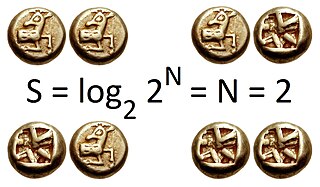
In algorithmic information theory, the Kolmogorov complexity of an object, such as a piece of text, is the length of a shortest computer program that produces the object as output. It is a measure of the computational resources needed to specify the object, and is also known as algorithmic complexity, Solomonoff–Kolmogorov–Chaitin complexity, program-size complexity, descriptive complexity, or algorithmic entropy. It is named after Andrey Kolmogorov, who first published on the subject in 1963 and is a generalization of classical information theory.
In the computer science subfield of algorithmic information theory, a Chaitin constant or halting probability is a real number that, informally speaking, represents the probability that a randomly constructed program will halt. These numbers are formed from a construction due to Gregory Chaitin.
Information theory is the scientific study of the quantification, storage, and communication of information. The field was fundamentally established by the works of Harry Nyquist and Ralph Hartley, in the 1920s, and Claude Shannon in the 1940s. The field is at the intersection of probability theory, statistics, computer science, statistical mechanics, information engineering, and electrical engineering.

In information theory, the entropy of a random variable is the average level of "information", "surprise", or "uncertainty" inherent to the variable's possible outcomes. Given a discrete random variable , which takes values in the alphabet and is distributed according to :
A binary symmetric channel is a common communications channel model used in coding theory and information theory. In this model, a transmitter wishes to send a bit, and the receiver will receive a bit. The bit will be "flipped" with a "crossover probability" of p, and otherwise is received correctly. This model can be applied to varied communication channels such as telephone lines or disk drive storage.
Minimum message length (MML) is a Bayesian information-theoretic method for statistical model comparison and selection. It provides a formal information theory restatement of Occam's Razor: even when models are equal in their measure of fit-accuracy to the observed data, the one generating the most concise explanation of data is more likely to be correct. MML was invented by Chris Wallace, first appearing in the seminal paper "An information measure for classification". MML is intended not just as a theoretical construct, but as a technique that may be deployed in practice. It differs from the related concept of Kolmogorov complexity in that it does not require use of a Turing-complete language to model data.
Minimum Description Length (MDL) is a model selection principle where the shortest description of the data is the best model. MDL methods learn through a data compression perspective and are sometimes described as mathematical applications of Occam's razor. The MDL principle can be extended to other forms of inductive inference and learning, for example to estimation and sequential prediction, without explicitly identifying a single model of the data.
In information theory, the information content, self-information, surprisal, or Shannon information is a basic quantity derived from the probability of a particular event occurring from a random variable. It can be thought of as an alternative way of expressing probability, much like odds or log-odds, but which has particular mathematical advantages in the setting of information theory.
Algorithmic information theory (AIT) is a branch of theoretical computer science that concerns itself with the relationship between computation and information of computably generated objects, such as strings or any other data structure. In other words, it is shown within algorithmic information theory that computational incompressibility "mimics" the relations or inequalities found in information theory. According to Gregory Chaitin, it is "the result of putting Shannon's information theory and Turing's computability theory into a cocktail shaker and shaking vigorously."
Intuitively, an algorithmically random sequence is a sequence of binary digits that appears random to any algorithm running on a universal Turing machine. The notion can be applied analogously to sequences on any finite alphabet. Random sequences are key objects of study in algorithmic information theory.
In computer science, locality-sensitive hashing (LSH) is an algorithmic technique that hashes similar input items into the same "buckets" with high probability. Since similar items end up in the same buckets, this technique can be used for data clustering and nearest neighbor search. It differs from conventional hashing techniques in that hash collisions are maximized, not minimized. Alternatively, the technique can be seen as a way to reduce the dimensionality of high-dimensional data; high-dimensional input items can be reduced to low-dimensional versions while preserving relative distances between items.
In coding theory, concatenated codes form a class of error-correcting codes that are derived by combining an inner code and an outer code. They were conceived in 1966 by Dave Forney as a solution to the problem of finding a code that has both exponentially decreasing error probability with increasing block length and polynomial-time decoding complexity. Concatenated codes became widely used in space communications in the 1970s.
The entropic vector or entropic function is a concept arising in information theory. It represents the possible values of Shannon's information entropy that subsets of one set of random variables may take. Understanding which vectors are entropic is a way to represent all possible inequalities between entropies of various subsets. For example, for any two random variables , their joint entropy is at most the sum of the entropies of and of :
In 1973, Andrey Kolmogorov proposed a non-probabilistic approach to statistics and model selection. Let each datum be a finite binary string and a model be a finite set of binary strings. Consider model classes consisting of models of given maximal Kolmogorov complexity. The Kolmogorov structure function of an individual data string expresses the relation between the complexity level constraint on a model class and the least log-cardinality of a model in the class containing the data. The structure function determines all stochastic properties of the individual data string: for every constrained model class it determines the individual best-fitting model in the class irrespective of whether the true model is in the model class considered or not. In the classical case we talk about a set of data with a probability distribution, and the properties are those of the expectations. In contrast, here we deal with individual data strings and the properties of the individual string focused on. In this setting, a property holds with certainty rather than with high probability as in the classical case. The Kolmogorov structure function precisely quantifies the goodness-of-fit of an individual model with respect to individual data.
A locally decodable code (LDC) is an error-correcting code that allows a single bit of the original message to be decoded with high probability by only examining a small number of bits of a possibly corrupted codeword. This property could be useful, say, in a context where information is being transmitted over a noisy channel, and only a small subset of the data is required at a particular time and there is no need to decode the entire message at once. Note that locally decodable codes are not a subset of locally testable codes, though there is some overlap between the two.
Information distance is the distance between two finite objects expressed as the number of bits in the shortest program which transforms one object into the other one or vice versa on a universal computer. This is an extension of Kolmogorov complexity. The Kolmogorov complexity of a single finite object is the information in that object; the information distance between a pair of finite objects is the minimum information required to go from one object to the other or vice versa. Information distance was first defined and investigated in based on thermodynamic principles, see also. Subsequently, it achieved final form in. It is applied in the normalized compression distance and the normalized Google distance.
In mathematics, a set of natural numbers is called a K-trivial set if its initial segments viewed as binary strings are easy to describe: the prefix-free Kolmogorov complexity is as low as possible, close to that of a computable set. Solovay proved in 1975 that a set can be K-trivial without being computable.
Inductive probability attempts to give the probability of future events based on past events. It is the basis for inductive reasoning, and gives the mathematical basis for learning and the perception of patterns. It is a source of knowledge about the world.
The distributional learning theory or learning of probability distribution is a framework in computational learning theory. It has been proposed from Michael Kearns, Yishay Mansour, Dana Ron, Ronitt Rubinfeld, Robert Schapire and Linda Sellie in 1994 and it was inspired from the PAC-framework introduced by Leslie Valiant.
In mathematics, the incompressibility method is a proof method like the probabilistic method, the counting method or the pigeonhole principle. To prove that an object in a certain class satisfies a certain property, select an object of that class that is incompressible. If it does not satisfy the property, it can be compressed by computable coding. Since it can be generally proven that almost all objects in a given class are incompressible, the argument demonstrates that almost all objects in the class have the property involved. To select an incompressible object is ineffective, and cannot be done by a computer program. However, a simple counting argument usually shows that almost all objects of a given class can be compressed by only a few bits.





